View in other NatureServe Network Field Guides
NatureServe
Montana
Utah
Wyoming
Idaho
Wisconsin
British Columbia
South Carolina
Yukon
California
New York
Anise Swallowtail - Papilio zelicaon
Native Species
Global Rank:
G5
State Rank:
S5
Agency Status
USFWS:
USFS:
BLM:
External Links
General Description
[From Ferris and Brown 1981; Scott 1986; Opler and Wright 1999; Glassberg 2001; Pyle 2002] Forewing 3.8-4.0 cm. Tailed. Abdomen black with single lateral yellow band, except black in nitra form. Thorax shoulders usually yellow. Uppersurface of forewing black with broad yellow band (narrower in black form) running length of wing, distal row of yellow marginal spots tend to be flattened distally, two yellow bars on front of wing in black field; hindwing yellow with black veins except black marginal and submarginal area, submarginal row of blue spots end in a yellow-orange eyespot near tail with a round black pupil not connected to hindwing margin. Undersurface repeats uppersurface pattern, but yellow areas cream instead of bright yellow.
Phenology
One flight, May to early June in Alberta and higher mountains; several flights, mostly May to August in Oregon and Washington, March to September in lowland California; year round in southern California (Scott 1986). One flight in most of range, April to early August; two or three flights in Pacific lowlands, year round in extreme south (Glassberg 2001). April to July in Rocky Mountain states (Ferris and Brown 1981), mid-April to late July in Colorado (Scott and Scott 1978; Scott and Epstein 1987), late June to early August at high elevation in northern California (Shapiro 1977), late March to late September in Oregon and Washington (Pyle 2002), late February to mid-September in Oregon (Warren 2005), April to mid-August in British Columbia (Threatful 1988; Guppy and Shepard 2001).
Diagnostic Characteristics
Best determined by combination of abdomen black with single lateral yellow band, except black in nitra form, Uppersurface of forewing black with broad yellow band (narrower in black form) running length of wing, distal row of yellow marginal spots tend to be flattened distally, hindwing submarginal row of blue spots end in a yellow-orange eyespot near tail with a free and round black pupil not connected to hindwing margin.
Species Range
Montana Range
Range Descriptions
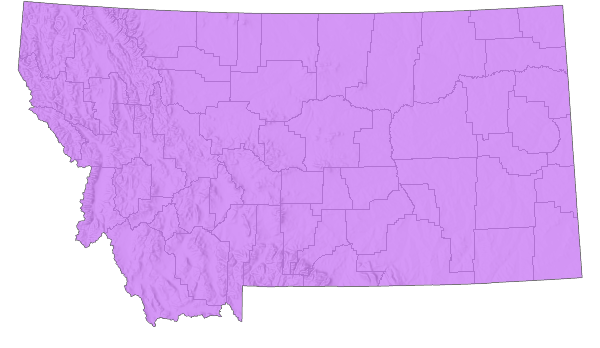
 Native
Native
Range Comments
British Columbia and Alberta southeast to western North Dakota, western South Dakota, western Nebraska, south to southern California and northern Baja California, northern Arizona, northern New Mexico (Ferris and Brown 1981; Scott 1986; Opler and Wright 1999; Glassberg 2001); 1829 m to 3962 m elevation (mostly below 2438 m) in the Rocky Mountain states (Ferris and Brown 1981), 1768 m to 3353 m elevation in south-central Colorado (Scott and Scott 1978), to at least 2743 m elevation in northern California (Shapiro 1977), near sea level to at least 2957 m elevation in Oregon (Warren 2005), sea level to at least 2438 m elevation in British Columbia (Threatful 1988; Guppy and Shepard 2001). In Montana, reported across the state from at least 42 counties (Kohler 1980; Stanford and Opler 1993; FLMNH Lepidopterists' Society database), to at least 1859 m elevation. Yellow form uncommon to common, black form rare to uncommon (Glassberg 2001).
Observations in Montana Natural Heritage Program Database
Number of Observations: 115
(Click on the following maps and charts to see full sized version)
Map Help and Descriptions
Relative Density
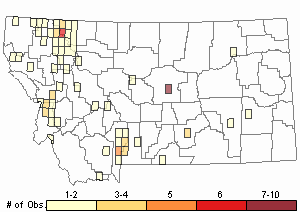
Recency
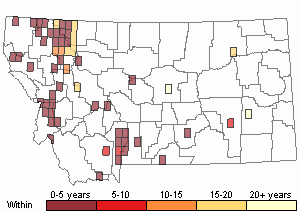
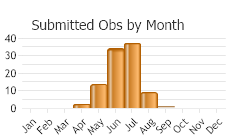
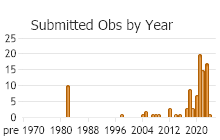
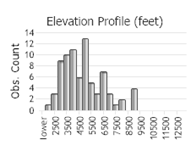 (Observations spanning multiple months or years are excluded from time charts)
(Observations spanning multiple months or years are excluded from time charts)
Migration
Non-migratory.
Habitat
Bare hills, mountains, alpine terrain, suburbs, cities, gardens, fields, riparian areas, saltmarsh, vacant lots, roadsides, power line corridors (Scott 1986; Threatful 1988; Opler and Wright 1999; Glassberg 2001; Pyle 2002; Warren 2005). Habitat in Montana probably similar; in Glacier National Park, Montana reported from mesic montane meadows and above treeline in alpine terrain (Debinski 1993).
Food Habits
Larval food plants include native and exotic members of the Apiaceae, including Ammi, Anethum, Angelica (several species), Apium, Carum, Cicuta, Conioselinum, Conium, Daucus, Foeniculum, Harbouria, Heracleum (multiple species), Ligusticum (multiple species), Lomatium (several species), Musineon, Oenanthe, Pastinaca, Perideridia (multiple species), Petroselinum, Pimpinella, Pseudocymopterus, Pteryxia (several species), Sphenosciadium, Tauschia (multiple species), Zizia, and Rutaceae, including Citrus (multiple species) and Ruta (Emmel and Shields 1978; Scott 1986, 1992, 2006; Wehling and Thompson 1997; Guppy and Shepard 2001; Pyle 2002; Graves and Shapiro 2003; Warren 2005; James and Nunnallee 2011). Adults feed on flower nectar (including Achillea, Allium, Apocynum, Aquilegia, Astragalus, Azalea, Balsamorhiza, Brassica, Brodiana, Camassia, Centranthus, Cirsium, Cleome, Coryphantha, Cryptantha, Delphinium, Eriogonum, Erodium, Erysimum, Harbouria, Helianthus, Heterotheca, Hymenoxys, Iris, Jamesia, Lathyrus, Lupinus, Medicago, Monarda, Oxytropis, Penstemon, Plantago, Potentilla, Prunus, Ribes, Raphanus, Rudbeckia, Salix, Senecio, Syringa, Thermopsis, Townsendia, Tragopogon, Wyethia) and mud (Pyle 2002; Scott 2014).
Reproductive Characteristics
Females lay eggs singly on host plant leaves and inflorescences, produce an average 82 eggs from 1-2 (rarely 3) matings (Sims 1979; Scott 1986, 1992, 2006; Wehling and Thompson 1997; James and Nunnallee 2011). Eggs hatch in about 4-6 days (depending on temperature), develop to L5 instar and pupate about 15-24 days post egg-hatch, with males developing 1-2 days faster than females; pupae overwinter (Scott 1979, 1986; Sims 1979; James and Nunnallee 2011). Larvae eat host plant leaves when young, inflorescences when older, build no nest, wander for up to 2 days before pupation on a host plant stem, pupae may remain in diapause for 2 years (Scott 1986; James and Nunnallee 2011). Males patrol and perch throughout the day, often on large hilltops or around larval food plants, in search or wait of females (Scott 1975; Pyle 2002; James and Nunnallee 2011).
Stewardship Responsibility
References
- Literature Cited AboveLegend:
 View Online Publication
View Online Publication Debinski, D. 1993. Butterflies of Glacier National Park, Montana. Occasional Papers of the Museum of Natural History, the University of Kansas, Lawrence, Kansas. No. 159: 1-13.
Debinski, D. 1993. Butterflies of Glacier National Park, Montana. Occasional Papers of the Museum of Natural History, the University of Kansas, Lawrence, Kansas. No. 159: 1-13. Emmel, J.F. and O. Shields. 1978. The biology of Plebejus (Icaricia) shasta in the western United States (Lycaenidae). Journal of Research on the Lepidoptera 17: 129-140.
Emmel, J.F. and O. Shields. 1978. The biology of Plebejus (Icaricia) shasta in the western United States (Lycaenidae). Journal of Research on the Lepidoptera 17: 129-140. Ferris, C.D. and F.M. Brown (eds). 1981. Butterflies of the Rocky Mountains. Univ. of Oklahoma Press. Norman. 442 pp.
Ferris, C.D. and F.M. Brown (eds). 1981. Butterflies of the Rocky Mountains. Univ. of Oklahoma Press. Norman. 442 pp. Glassberg, J. 2001. Butterflies through Binoculars: A Field Guide to the Butterflies of Western North America. Oxford University Press.
Glassberg, J. 2001. Butterflies through Binoculars: A Field Guide to the Butterflies of Western North America. Oxford University Press. Graves, S.D. and A.M. Shapiro. 2003.Exotics as host plants of the California butterfly fauna. Biological Conservation 110: 413-433.
Graves, S.D. and A.M. Shapiro. 2003.Exotics as host plants of the California butterfly fauna. Biological Conservation 110: 413-433. Guppy, C.S. and J.H. Shepard. 2001. Butterflies of British Columbia: including western Alberta, southern Yukon, the Alaska Panhandle, Washington, northern Oregon, northern Idaho, northwestern Montana. UBC Press (Vancouver, BC) and Royal British Columbia Museum (Victoria, BC). 414 pp.
Guppy, C.S. and J.H. Shepard. 2001. Butterflies of British Columbia: including western Alberta, southern Yukon, the Alaska Panhandle, Washington, northern Oregon, northern Idaho, northwestern Montana. UBC Press (Vancouver, BC) and Royal British Columbia Museum (Victoria, BC). 414 pp. James, D.G. and D. Nunnallee. 2011. Life histories of Cascadia butterflies. Corvallis, OR: Oregon State University Press. 447 p.
James, D.G. and D. Nunnallee. 2011. Life histories of Cascadia butterflies. Corvallis, OR: Oregon State University Press. 447 p. Kohler, S. 1980. Checklist of Montana Butterflies (Rhopalocera). Journal of the Lepidopterists' Society 34(1): 1-19.
Kohler, S. 1980. Checklist of Montana Butterflies (Rhopalocera). Journal of the Lepidopterists' Society 34(1): 1-19. Opler, P.A. and A.B. Wright. 1999. A field guide to western butterflies. Second edition. Peterson Field Guides. Houghton Mifflin Company, Boston, Massachusetts. 540 pp.
Opler, P.A. and A.B. Wright. 1999. A field guide to western butterflies. Second edition. Peterson Field Guides. Houghton Mifflin Company, Boston, Massachusetts. 540 pp. Pyle, R.M. 2002. The butterflies of Cascadia: a field guide to all the species of Washington, Oregon, and surrounding territories. Seattle Audubon Society, Seattle, Washington. 420 pp.
Pyle, R.M. 2002. The butterflies of Cascadia: a field guide to all the species of Washington, Oregon, and surrounding territories. Seattle Audubon Society, Seattle, Washington. 420 pp. Scott, J.A. 1975b. Mate-locating behavior of western North American butterflies. Journal of Research on the Lepidoptera 14:1-40.
Scott, J.A. 1975b. Mate-locating behavior of western North American butterflies. Journal of Research on the Lepidoptera 14:1-40. Scott, J.A. 1979. Hibernal diapause of North American Papilionoidea and Hesperioidea. Journal of Research on the Lepidoptera 18(3): 171-200.
Scott, J.A. 1979. Hibernal diapause of North American Papilionoidea and Hesperioidea. Journal of Research on the Lepidoptera 18(3): 171-200. Scott, J.A. 1986. The butterflies of North America: a natural history and field guide. Stanford University Press, Stanford, California.
Scott, J.A. 1986. The butterflies of North America: a natural history and field guide. Stanford University Press, Stanford, California. Scott, J.A. 1992. Hostplant records for butterflies and skippers (mostly from Colorado) 1959-1992, with new life histories and notes on oviposition, immatures, and ecology. Papilio new series #6. 185 p.
Scott, J.A. 1992. Hostplant records for butterflies and skippers (mostly from Colorado) 1959-1992, with new life histories and notes on oviposition, immatures, and ecology. Papilio new series #6. 185 p. Scott, J.A. 2006. Butterfly hostplant records, 1992-2005, with a treatise on the evolution of Erynnis, and a note on new terminology for mate-locating behavior. Papilio new series #14. 74 p.
Scott, J.A. 2006. Butterfly hostplant records, 1992-2005, with a treatise on the evolution of Erynnis, and a note on new terminology for mate-locating behavior. Papilio new series #14. 74 p. Scott, J.A. 2014. Lepidoptera of North America 13. Flower visitation by Colorado butterflies (40,615 records) with a review of the literature on pollination of Colorado plants and butterfly attraction (Lepidoptera: Hersperioidea and Papilionoidea). Contributions of the C.P. Gillette Museum of Arthopod Diversity. Fort Collins, CO: Colorado State University. 190 p.
Scott, J.A. 2014. Lepidoptera of North America 13. Flower visitation by Colorado butterflies (40,615 records) with a review of the literature on pollination of Colorado plants and butterfly attraction (Lepidoptera: Hersperioidea and Papilionoidea). Contributions of the C.P. Gillette Museum of Arthopod Diversity. Fort Collins, CO: Colorado State University. 190 p. Scott, J.A. and G.R. Scott. 1978. Ecology and distribution of the butterflies of southern central Colorado. Journal of Research on the Lepidoptera 17(2): 73-128.
Scott, J.A. and G.R. Scott. 1978. Ecology and distribution of the butterflies of southern central Colorado. Journal of Research on the Lepidoptera 17(2): 73-128. Scott, J.A. and M.E. Epstein. 1987. Factors affecting phenology in a temperate insect community. American Midland Naturalist 117(1): 103-118.
Scott, J.A. and M.E. Epstein. 1987. Factors affecting phenology in a temperate insect community. American Midland Naturalist 117(1): 103-118. Shapiro, A.M. 1977. The alpine butterflies of Castle Peak, Nevada County, California. Great Basin Naturalist 37(4): 443-452.
Shapiro, A.M. 1977. The alpine butterflies of Castle Peak, Nevada County, California. Great Basin Naturalist 37(4): 443-452. Sims, S.R. 1979. Aspects of mating frequency and reproductive maturity in Papilio zelicaon. American Midland Naturalist. 102(1): 36-50.
Sims, S.R. 1979. Aspects of mating frequency and reproductive maturity in Papilio zelicaon. American Midland Naturalist. 102(1): 36-50. Stanford, R.E. and P.A. Opler. 1993. Atlas of western USA butterflies: including adjacent parts of Canada and Mexico. Unpubl. Report. Denver and Fort Collins, Colorado 275 pp.
Stanford, R.E. and P.A. Opler. 1993. Atlas of western USA butterflies: including adjacent parts of Canada and Mexico. Unpubl. Report. Denver and Fort Collins, Colorado 275 pp. Threatful, D.L. 1988. A list of the butterflies and skippers of Mount Revelstoke and Glacier National Parks, British Columbia, Canada (Lepidoptera). Journal of Research on the Lepidoptera 27(3-4): 213-221.
Threatful, D.L. 1988. A list of the butterflies and skippers of Mount Revelstoke and Glacier National Parks, British Columbia, Canada (Lepidoptera). Journal of Research on the Lepidoptera 27(3-4): 213-221. Warren, A.D. 2005. Lepidoptera of North America 6: Butterflies of Oregon, their taxonomy, distribution, and biology. Contributions of the C. P. Gillette Museum of Arthropod Diversity, Colorado State University. Fort Collins, Colorado. 406 pp.
Warren, A.D. 2005. Lepidoptera of North America 6: Butterflies of Oregon, their taxonomy, distribution, and biology. Contributions of the C. P. Gillette Museum of Arthropod Diversity, Colorado State University. Fort Collins, Colorado. 406 pp. Wehling, W.F. and J.N. Thompson. 1997. Evolutionary conservatism of oviposition preference in a widespread polyphagous insect herbivore, Papilio zelicaon. Oecologia. 111(2): 209-215.
Wehling, W.F. and J.N. Thompson. 1997. Evolutionary conservatism of oviposition preference in a widespread polyphagous insect herbivore, Papilio zelicaon. Oecologia. 111(2): 209-215.
- Additional ReferencesLegend:
 View Online Publication
View Online Publication
Do you know of a citation we're missing? Allen, T.J., J.P. Brock, and J. Glassberg. 2005. Caterpillars in the field and garden: a field guide to the butterfly caterpillars of North America. Oxford University Press.
Allen, T.J., J.P. Brock, and J. Glassberg. 2005. Caterpillars in the field and garden: a field guide to the butterfly caterpillars of North America. Oxford University Press. Brock, J.P. and K. Kaufman. 2003. Kaufman Field Guide to Butterflies of North America. Houghton Mifflin Company, New York, NY 284 pp.
Brock, J.P. and K. Kaufman. 2003. Kaufman Field Guide to Butterflies of North America. Houghton Mifflin Company, New York, NY 284 pp. Caruthers, J.C., and D. Debinski. 2006. Montane meadow butterfly species distributions in the Greater Yellowstone Ecosystem. University of Wyoming National Park Service Research Center Annual Report, 2006. Vol. 30, Art. 14. 85-96.
Caruthers, J.C., and D. Debinski. 2006. Montane meadow butterfly species distributions in the Greater Yellowstone Ecosystem. University of Wyoming National Park Service Research Center Annual Report, 2006. Vol. 30, Art. 14. 85-96. Forister, M.L., C.A. Halsch, C.C. Nice, J.A. Fordyce, T.E. Dilts, J.C. Oliver, K.L. Prudic, A.M. Shapiro, J.K. Wilson, J. Glassberg. 2021. Fewer butterflies seen by community scientists across the warming and drying landscapes of the American West. Science 371:1042-1045.
Forister, M.L., C.A. Halsch, C.C. Nice, J.A. Fordyce, T.E. Dilts, J.C. Oliver, K.L. Prudic, A.M. Shapiro, J.K. Wilson, J. Glassberg. 2021. Fewer butterflies seen by community scientists across the warming and drying landscapes of the American West. Science 371:1042-1045. Forister, M.L., E.M. Grames, C.A. Halsch, K.J. Burls, C.F. Carroll, K.L. Bell, J.P. Jahner, et al. 2023. Assessing risk for butterflies in the context of climate change, demographic uncertainty, and heterogeneous data sources. Ecological Monographs 93(3):e1584. https://doi.org/10.1002/ecm.1584
Forister, M.L., E.M. Grames, C.A. Halsch, K.J. Burls, C.F. Carroll, K.L. Bell, J.P. Jahner, et al. 2023. Assessing risk for butterflies in the context of climate change, demographic uncertainty, and heterogeneous data sources. Ecological Monographs 93(3):e1584. https://doi.org/10.1002/ecm.1584 Layberry, R.A., P.W. Hall, and J.D. LaFontaine. 1998. The Butterflies of Canada. University of Toronto Press. 280 pp. + color plates.
Layberry, R.A., P.W. Hall, and J.D. LaFontaine. 1998. The Butterflies of Canada. University of Toronto Press. 280 pp. + color plates. Opler, P.A., K. Lotts, and T. Naberhaus, coordinators. 2010. Butterflies and moths of North America. Big Sky Institute, Bozeman, MT. Available at: www.butterfliesandmoths.org (Accessed 15 June 2015).
Opler, P.A., K. Lotts, and T. Naberhaus, coordinators. 2010. Butterflies and moths of North America. Big Sky Institute, Bozeman, MT. Available at: www.butterfliesandmoths.org (Accessed 15 June 2015).
- Web Search Engines for Articles on "Anise Swallowtail"
- Additional Sources of Information Related to "Insects"





